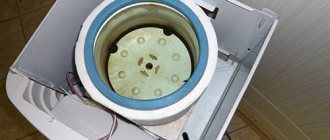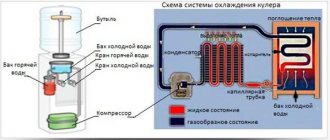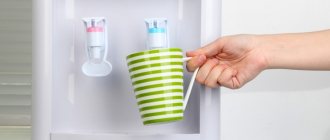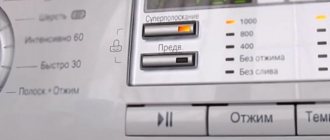It makes sense to contact a service center or call a specialist in the rarest cases. For example, in winter, in unheated rooms, a hot water tank sometimes bursts. The cooler can crack from the inside when it is moved without draining the water from the barrels; in such cases, the internal tubes are often damaged. There is a high chance of damage to some faucet when a large number of people use the cooler.
Poor quality packaging is one of the most common reasons why a water cooler leaks.
For some people, the cooler can work properly for many years, while others constantly face the problem of leakage. The reason lies in how correctly the dispenser was used. And this is sometimes very difficult to control. After all, the device can be used by several family members or a large team of office employees.
Although it also happens that a cooler can leak, even if it has one very thrifty owner. Therefore, before the puddle that forms under the dispenser ruins your mood and entails unplanned expenses, you should figure out what problems can be prevented by everyone who bought this useful device.
There is a possibility that the dispenser itself does not need repair. It happens that the integrity of the bottle itself, which contains purified water for the cooler, is broken.
When there is a microcrack in the bottle
It is likely that the device itself has nothing to do with it. The reasons why your water cooler is leaking may lie in a damaged bottle. The supplier simply brought low-quality packaging. Sometimes this is noticeable right away. But it happens that the crack is so small that it is difficult to detect. To avoid guessing from the coffee grounds, we recommend following a series of simple steps to replace a suspicious bottle with a new one.
There is a possibility that the bottle will be of poor quality
Algorithm for changing containers on a cooler:
- First of all, turn off the cold and hot water supply toggle switches on the back wall of the device.
- After this, turn off the power to the device by disconnecting it from the network.
- Carefully remove the problematic container from the bottle receptacle slot.
- To drain the water from the floor cooler, locate the drain valve on the back wall. Unscrew the lid from it.
- Remove the silicone plugs from the tabletop structure. Look for them at the bottom of the device.
- After this, close the tap and return all parts to their places.
- At the end of the operation, install a new bottle.
Start using the cooler. If a new puddle does not appear, then the problem is solved. If the actions do not bring results, take care of the unit itself.
Hot water tap does not flow
If you open a hot tap and the water barely drips or does not flow at all, you need to replace the bottle. But if cold water flows from a hot tap, then in this case you need to:
- Wait 15-20 minutes until the heat exchanger radiator heats up and try to get hot water again.
- Check the power supply - the dispenser may have been disconnected from the network, and without electricity it only dispenses cold water.
- Turn on the fuse - when overheating, the cooler is disconnected from the network, de-energizing the heating circuit.
What to do if there is a full bottle on the cooler and it is plugged in? Of course, contact the specialists from the service center. In this case, repairing coolers yourself is impossible. The technician will have to disassemble the device, remove the broken or clogged heat exchanger, wash it and put it back in place. Along the way, he will check the wiring and change the fuses. This work cannot be done without a special tool.
Even the most experienced craftsman will not be able to make a dispenser at home. Therefore, do not waste money on calling specialists - immediately take the cooler to the service center.
The cause of the leak may be in the faucet.
So, if it turns out that the container is in order, then the next culprit of the leak may be the tap. But even if it is faulty, this is not a reason to immediately call the service center. It is quite possible to adjust, repair and even replace the faucet yourself. It happens that a piece of protective film from the bottle gets into the tap and turns it off. You can solve the problem by unscrewing the top cover, removing a piece of film and tightly screwing the faucet cap. Before manipulating the faucet, it is best to read the instructions for this cooler.
However, the faucet may leak due to serious damage if the device is in a cold room. In winter, temperature changes can cause the hot water tank to crack.
Often the hot water faucet begins to drip due to the fact that limescale has accumulated inside it. You need to remove the cap and clean the valve with your hands, scraping off the plaque.
Internal damage to the faucet or supply pipes may occur due to rough movement of the device from place to place.
If a large number of people use the dispenser, then one of these careless users may simply break the tap.
How to replace a cooler tap with your own hands
Most modern water dispensers have spare parts that are readily available from the manufacturers. And to install many of these basic parts, incl. and taps, do not even require tools other than a regular screwdriver or wrench. If you don’t intuitively understand how to replace an old faucet, read about it in the instructions for the device.
As a last resort, if you do not have the original spare valve, you can temporarily use regular water ball valves. They are simply screwed onto threaded fittings, with waterproofing tape.
Very often, customers contact us about water leaks.
The working cooler suddenly begins to leak inside, and a puddle of water forms under it. In 99% of cases, the reason is a defective bottle - it has a microcrack through which air is sucked into the system - the cooler tanks overflow and begin to leak over the edge. This is a defect of the bottle, not the cooler. You just need to replace the bottle with another one, drain 1 liter of water from each tap and the problem is solved. To do this, you don’t need to take the cooler to a service center or call a specialist - everything can be solved by simply replacing the bottle.
Leaks from under the lid at the top
Such a malfunction will most likely require contacting a service center or calling a specialist. If this is a new cooler, then a possible reason is that there is no special button in the water drain valve.
If a leak occurs over time, then this is a serious signal about the need for a thorough repair or replacement of the bottle receiver. But the reason may be more prosaic - in the leaky cap of the bottle itself, this is written in paragraphs 5 and 6 of the above instructions on the procedure for primary diagnosis.
General provisions
| Designation in the figure | Name |
| 1 | Bottle installation location |
| 2 | Green cooling indicator |
| 3 | Red heating indicator |
| 4 | Yellow power indicator |
| 5 | Cold water tap |
| 6 | Hot water tap |
| 7 | Collection container for drops |
| 8 | Cooling system |
| 9 | Cooling thermostat |
| 10 | Green cooling switch |
| 11 | Red heating switch |
| 12 | Cooling radiator |
| 13 | Network connection wire |
| 14 | Drain valve |
| 15 | Grounding |
As you can see from the given structure of the water dispenser, the faucets are indeed precisely the part with which a person who decides to drink from the cooler comes into contact. Consequently, the requirements for it must be special.
Would you like iced tea or...
I remembered after this post: A knife that heats up and marketers that heat up
About 12 years ago, I worked in a computer store in a warehouse. The task was quite simple: an order comes from a client, you need to find one or more items in the warehouse and bring it for pick-up. The rest of the time the tasks were minimal and it was possible to get tea/coffee. There was no cold water in the warehouse, only a kettle and a tap, which meant we had to wait until it cooled down. As always, while this is happening, work arrives, you forget about your seagull, and when the time comes, it is already cold. Sometimes I brought a bottle of water, but it’s a waste of time, you need to make a detour to go to the store and it’s expensive, especially considering that it wasn’t just me who used it, who would ask permission?)) This is generally a separate topic for conversation, taking food without asking.
After the weekend, when I went to work I came across a processor cooler, or rather just a radiator without a fan, no one knew where it came from or what to do with it, there was no marking, kit or box, and the inventory didn’t give anything, we shouldn’t have such a position . Don't throw it away. For some time he just lay nearby on the table, and attempts to find out his fate led nowhere (cameras were difficult at that time, the quality was poor and they did not always work for recording). In another rush, I pour myself some tea, thinking that I won’t drink it again, while I’m sitting my eyes fell on this same radiator, it looked something like this:
I remember exactly that it was two-section, and the number of copper tubes was from four to six. The thought came to mind: “after all, these things cope well with hot processors,” what if we try to cool tea with it? I wiped it off from dust and placed it in a mug for a couple of minutes. And I clearly underestimated the capabilities of these towers! When I took the radiator in my hand, it was close to hot, but when I tried the tea, it turned out to be almost cold, the tower took almost all the heat from the tea. Empirically, I determined the time it takes for the tea to be brought to the desired state; ~20 seconds is enough. After several shifts, when I came to work, I didn’t find the radiator, no one knew its fate...
alban85
3 years ago
How to fix a cooler faucet with internal threads
To change a clogged tap with internal thread, you need to follow the following plan:
- Unplug the device and remove the water bottle. You will have to partially disassemble the supply line, and this work should only be done with the electricity turned off and the water tank removed.
- Remove failed fittings. To fix a faulty supply line, you need to remove the shut-off device from the pipe. To do this, turn the shut-off fitting counterclockwise, moving it out of place, and twist the broken assembly from the threaded fitting or fitting.
- Buy replacement parts based on the brand of your cooler. Some models support mug pressure, others - hand pressure. If you are not sure that you understand the characteristics of your valve, take it with you to the store and show it to the consultant.
- Before replacing a part that comes into contact with drinking water, it is worth washing it inside and out. Therefore, wash it in a solution of soda or soap, under a strong stream of hot water.
- Put on gloves, pick up the washed fitting, screw it onto the thread, turning it clockwise.
Finally, you need to check how the liquid flows from the new valve. To do this, place a bottle on the cooler and open the valve. At the very beginning, air will come out of the pipe. The water will appear a little later, at first it drips in a thin stream, and then flows in a wide stream. Wait for a steady stream and close the valve. Your dispenser can now be plugged into a power outlet.
Using the same scheme, you can repair a device in which hot or cold water drips from the tap with the valves closed.
Methods for eliminating cooler leaks
The cause of malfunction of the equipment may be the settling of untreated water deposits on the walls of the device. As a result, clogging occurs, which is why the cooler begins to leak or the water stops flowing.
In this case, you can troubleshoot the problem in the following way:
- Turn off the device. This can be achieved by pressing the “0” or “Off” buttons on the back of the device. After this, you need to remove the plug from the outlet (disconnect from the power supply).
- Get the container.
- Wash it thoroughly using detergent.
- Rinse the bottle.
- Clean all thin taps, eliminating any detergent remaining in them.
- Put it in place. Drain half a liter of water, washing away any remaining detergent.
The reason may be damage to the water container or the appearance of cracks on it. If during inspection they are identified, then the breakdown can be solved by simply replacing the damaged container with a new one. To replace, you must first turn off the device, disconnect the bottle and replace it with a new one. Damaged items are returned to the supplier.
It is important to pay attention to the amount of water in the bottle. It should be poured so that the liquid does not exceed the level of the neck. If the leak stops when you remove the container, this indicates that the problem is in the bottle itself.
The cause of the leak may also be a malfunction of the taps. You need to look at them carefully. If a breakdown is detected, the taps must be replaced.
The cooler may leak from under the cap on top. To determine this, you can remove the bottle and then look into the bottle receiver glass. If it is full, then the cause has been found. To solve the problem, you need to replace the lid on the container. You can purchase it in a specialized store. It doesn't matter if it's disposable or reusable.
One of the most important recommendations when buying a cooler is to keep the instructions. It indicates the most common causes of breakdowns. Therefore, you can fix the cooler yourself, following the instructions in the instructions.
If damage is not detected, then the problem lies much deeper. It is better to seek help from a specialist.
Water may also pour out of the top of the appliance if a special plug is not installed in the drain valve. It is impossible to install it yourself, so you will have to resort to the services of a specialist.
The washing machine is broken
Life hack, it may be useful to someone, but I’m not sure it will work on all washing machines. My wife started washing, the machine stopped with half a tank of water and issued E03. The forums said: 1. The pump is broken 2. The outlet pipes are clogged 3. The water level sensor is broken. There are instructions for everything about everything, how to disassemble and repair. I got lazy. First, unplug it from the socket and shake it, turn it on, the error goes away. Turned it on. 5 minutes and the error appeared again. My wife has already sat down to look at the new washing machines being delivered. And I... and I remembered my plumbing past. He pulled the drain hose out of the canal, took in more air and blew three times. The washing machine responded with bubbling in the tank. Well, the air has flowed, which means the water will flow. I turn it on, there is no error, I put it on spin and I hear water flowing into the channel. That's it, the machine has spun out and is already humming for the second wash.
gromt
4 years ago
When your water cooler leaks, it's helpful to refer to the instructions.
By looking through the cooler's operating manual, you can also familiarize yourself with options for eliminating the main causes of leaks. However, most dispenser users throw away such instructions. The real lucky ones are the owners of floor coolers with a counter-flow system. But it happens that this option also needs fixing. Often in such systems, the seal on the bottle receiver slips, or the needle falls through.
What to do if everything is fine with the container?
First of all, do not despair, since it is too early to call the service center. We have compiled a list of the most common reasons why the cooler leaks, as well as the actions that need to be taken to eliminate this or that breakdown:
- if the drain plug is leaking, then just try to tighten it;
- if a fragment of the protective film gets into the faucet, then unscrew the top cover, remove the film and screw the faucet cap tightly;
- If you are not sure of the correctness of your actions (for example, you open the tap incorrectly), then read the operating instructions for the water cooler.
Why is the cooler leaking from below, the problem is in the tank
The seal of the water column cannot be maintained if there is a crack somewhere. In such a situation, the storage tank overflows and a puddle appears under the device. In this case, water flows down the inner, not outer, walls of the cooler. Most often, cracks in the bottle occur from below (at the bottom) and are formed during rough transportation of the container.
But sometimes microcracks appear on the side walls of the bottle. In such cases, the dispenser initially works normally, but begins to leak when the water level drops below the microcrack. If you see a puddle under the cooler, immediately check the storage tank.
If the water cooler is leaking from below (there is a puddle under the device), most likely the storage tank is full. This means that the seal of the bottle is broken and needs to be changed. But if the tank is not full, then the problem is in itself, or in the tubes coming from it. Or in the check valve, which is connected below the tank.
Poor quality packaging supplied
Your dispenser can be intact and completely intact. those. it does not need any repairs, and the existing leak is due to a small, often invisible, crack in the water cylinder itself. It can be quite difficult to determine during a visual inspection whether there is a microcrack in the bottle or not. And this is the first reason that you need to think about and which you can eliminate yourself. If a water cooler leaks, the reason in 95% of cases is damage to the bottle.
Poor-quality containers may be cracked due to rough transportation, or may leak due to a leaky lid.
What to do if the problem is in the packaging
If you have a spare bottle of clean water, replace it. If the leak stops, return the cracked container to the seller, he is obliged to replace it.
If there is no spare full bottle, then you need to perform the following algorithm of actions to eliminate this, the most common, cause of cooler leakage.
- Turn off heating and cooling. The toggle switches are located on the back wall of the device.
- Turn off the dispenser completely, i.e. pull out the plug from the socket.
- Carefully pull out the plastic bottle from the bottle receiver socket.
- Look into the nest - if there is water in it, it means the bottle cap is not sealed. There is no need to look further for reasons.
- Unscrew the bottle receptacle clockwise.
- Look at the storage tank, if it is full, then the bottle is cracked and not sealed. You don’t have to look any further. If the tank is not full, then manually fill it with water up to half the volume.
- Connect the device to the network and check its functionality. If the leak persists, this means that the cause is still in the cooler itself.
How to use a cooler correctly
To avoid breakdowns, you need to follow some rules:
- Clean the container and all equipment regularly (at least 1-2 times a week).
- Don’t forget to turn off the water cooler if the liquid in the container runs out.
- When the device is operating in cooling mode, do not use the thermostat.
- If the appliance is set to heating or cooling mode, it must not be disconnected from the power supply.
- Only purified water can be used.
- Remove stickers, labels, corks, films before using a new container.
- Monitor the air temperature in the room where the device is installed. If it is very low, the hot water tank will burst.
- Do not move the device from one place to another if it is filled with water. There is a chance of damaging the internal tubes.
Careful, careful handling of the cooler can protect it from many breakdowns and leaks and ensure its long-term operation.
When should I take my cooler in for repair?
As you can see, you can do without the help of specialists only in rare cases, since quite often the cooler leaks due to a more serious breakdown:
- in an unheated room (especially in winter), the hot water tank may burst;
- after moving the dispenser (without first draining the water from the tanks), the internal tubes may be damaged;
- There is also the possibility of mechanical damage to the faucet, which will have to be replaced.
Pinch or contamination of the hose
This can be considered a consequence of incorrect manufacturing assembly of the device. This specifically concerns the fastening of faucets. They can be screwed on incorrectly. As a result, the tube through which water is supplied will be pinched. This in turn will block the water supply.
To eliminate the problem, you will have to disassemble the cooler. It will be difficult for a person who does not know the technical intricacies to do this on his own. Defects are often discovered immediately after purchase. If the cooler is under warranty, you won’t have to pay anything.
The power of knowledge or the “painful” experience of the past?
Proper handling of the water cooler is at least a 90% guarantee that it will work without breakdowns for many years, so teach your household, office employees and other people who have constant access to the cooler to use it correctly. But in public places (i.e. with free access to the dispenser), you can only hope that the actions of your customers will not cause a breakdown of this equipment.
- Cooler from “A” to “Z”: installation, operation and care
- What is purifier
- Cooler failures
Where to buy a quality water cooler
engages in supplies to Russia of coolers, pumps and related equipment designed for bottling water from bottles of various sizes. All equipment is supplied under the “ECOCENTER” brand.
We provide the best price-quality ratio of equipment, and also offer our partners excellent service and flexible terms of cooperation.
You can see the attractiveness of collaboration by comparing our prices with similar equipment from other suppliers.
All our equipment meets the standards established in Russia and has quality certificates. We deliver dispensers to our customers, as well as all the necessary spare parts and components in the shortest possible time.
Start of cleaning
The question “how to disassemble a cooler” is quite easy to deal with. The first step is to disconnect the computer from the network and disconnect all existing cords. The next step is to remove the housing cover from the left side, while carefully placing the unit on the right side. Next, you need to clean the internal parts of the computer from dust and foreign contaminants.
Since the cooler’s job is to properly distribute air flows, the part, accordingly, removes a lot of dust and small debris from the environment. Most of the unnecessary dust contaminants settle on the radiator and other important components.
Cleaning can begin with the most general actions, for example, using a regular vacuum cleaner. But it’s better to finish more thoroughly - wipe the parts with a napkin moistened with any alcohol solution. You can use both cologne and vodka. Any alcohol-containing substance is good because it does not react with air, dries quickly and does not cause metal corrosion (which is typical for water). Depending on how finely and deeply the cleaning was carried out, the further operation of the computer depends.











